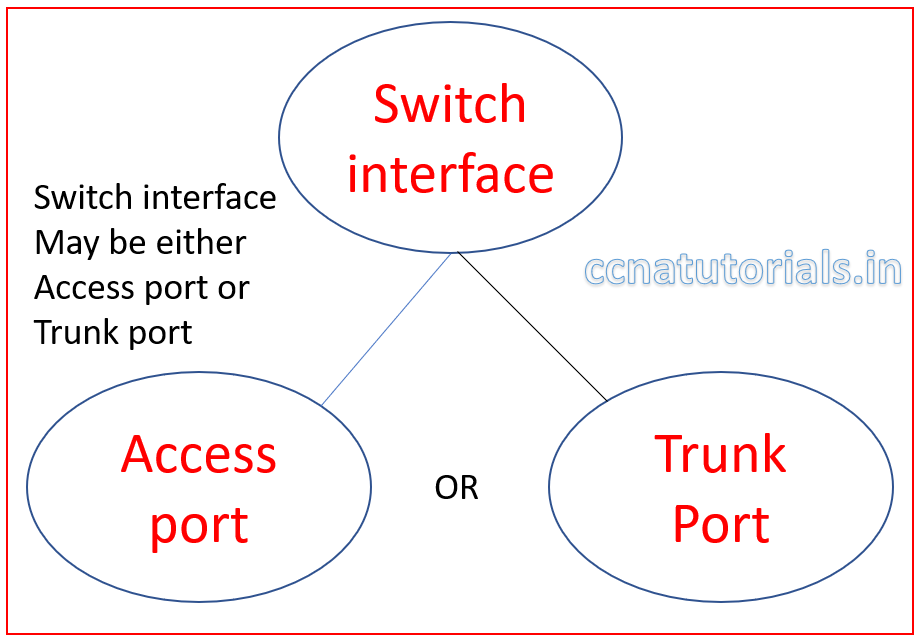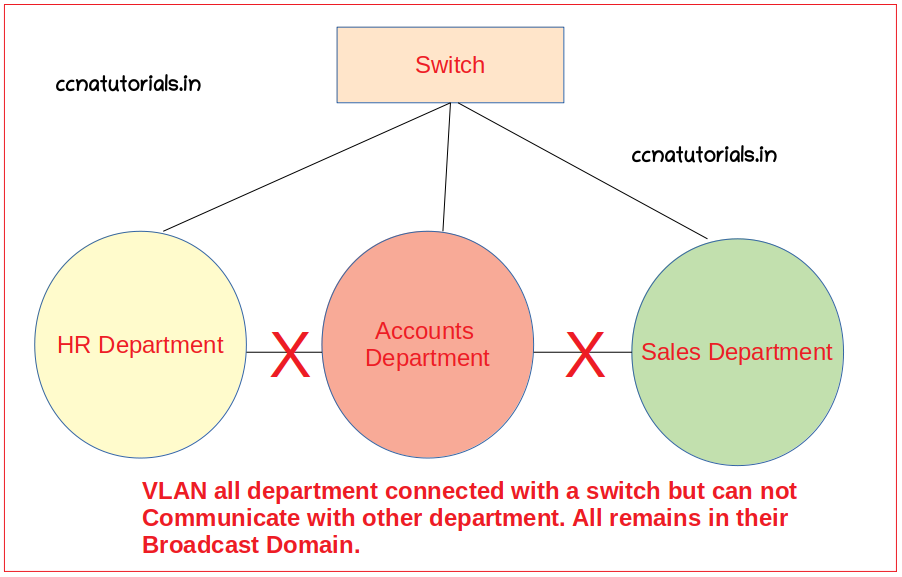In this article I describe the VLAN basic concepts for CCNA exam. VLAN provides multiple virtual networks in a physical network. We can break a local area network into multiple virtual networks. The devices of same virtual network can communicate with each other without interfere to other virtual network. The switchports of a switch can be used as access port or trunk port. The function of access port and trunk port are different.
The switch provide a single broadcast domain to all connected devices by default. Each port of switch creates single collision domain. VLAN breaks the broadcast domain into small broadcast domain. If we need to make communication between different VLANs then we need a router. Router have the feature to provide communication between different networks. VLAN provides the logical network within a single physical network.
VLAN basic concepts
Every switchport works on separate collision domain. We can say each device connected with a switchport remains in separate collision domain. By default all switchports of a switch works in a single broadcast domain. It can be define as all the devices working in a single LAN remains in a single broadcast domain. The big network of single broadcast domain can be divided into different small broadcast domains by creating the VLANs in the network. Every VLAN have its own broadcast domain.
Breaking the large broadcast domain into small broadcast domains provides an extra layer of security in the network. The devices of different broadcast domains can not communicate with each other. The swithports can be configured to restrict the unauthorised use by unwanted devices. Management of networking devices become easier by creating VLANs. Network administrator can monitor the small network more efficiently than a large network.
Methods of adding devices in VLAN
The devices can be added in a VLAN by two methods static and dynamic. Actually we configure the switchports for access by device with these methods. Generally static method assigned to the VLANs as it is easy and secure method. In static method we add the switchports manually to a VLAN. Suppose I assign the switchport number 4 to VLAN 10. This switchport remains assigned to VLAN unless we manually change it or assign to another VLAN. By default all switchports assigned to a single VLAN. We need to assign each port manually to the required VLAN.
The other method is dynamic assignment of swithports to VLAN according to the IP address of a device or MAC address of the device. Suppose a device connected to switchport 2 and it belongs to VLAN 20. If you change the switchport of this device from 2 to 10 then the switchport 10 automatically assigned to VLAN 20 and the device will work as it was. Dynamic method works in high end switches, in normal switch we can use static methods only.
Access port and Trunk port for VLAN basic concepts
Access ports allow a device to access the network by using the NIC or RJ45 connection. The devices connected to access ports remains in same broadcast domain. The device can access, receive and transmit the data via access port. Generally all switchports remains as access ports until we manually convert them to trunk ports.
Trunk port mode allow to transmit and receive the data of multiple VLANs. Generally endpoint devices not connected with trunk ports. The networking devices uses trunk ports to connect with each other. For example when we need to connect two switches which have multiple VLANs, the switches can be connected via trunk ports. The assignment of access ports and trunk ports are logical. A switchport mode can be changed by using the command line interface.

VLAN Basic Concepts are very important part of networking. VLAN stands for Virtual Local Area Network. As defined by its name the Local network created virtually known as VLAN. We learn that routers used for communication between different networks. It is known as internetworking. What if we have a LAN and wants to divide it into different LAN segment. Concept of VLAN raise from this question. If I have a small LAN which managed with some layer 3 switch, I want to divide this LAN into small LANs which do not interfere each other. The small LAN can only be created virtually otherwise we require a router to break the LAN into small LANs.
Here the basic concept of network and internetworking comes in picture. I mean Broadcast domain and Collision domain. We know that a Layer 3 switch breaks the collision domains and Router breaks the broadcast domains. Our requirement here is to break the LAN into broadcast domain. This requirement can be done by creating VLANs in a LAN by using Layer3 switch. To create VLAN in a LAN and communicate with each other is very easy now without Router.
Basic Requirements for creation of VLAN
VLAN basic concepts also require to know the basic requirement of VLAN. We have a simple LAN as shown in figure below. There is nothing require more than a layer3 switch to break the collision domains into broadcast domain. The different VLAN works on same subnet without disturbing other VLAN users. In the scenario shown in diagram below the LAN is divided into three segments.
The user of particular segment can communicate with each other. Communication between different VLAN users is not possible after creation of VLAN in switch. The switch interfaces works in two modes one is access port and another is trunk port. Access port allow a device to send and receive data from the same VLAN only. Trunk port transmit the data of all VLANs from one switch to another switch.

You can do same thing with a Layer2 switch by assigned different subnet mask to computer. The main difference between subnetting and VLAN is that subnetting take place on Layer2. VLAN works on Layer 3. now one question comes in mind how to communicate particular two VLAN without interfere Third VLAN. The answer is inter-VLAN Routing with the help of Router. Later we do configure the inter-VLAN routing. In this article we discuss only the VLAN basic concept.
Requirement and necessity of VLAN
In a small office the computer can be connected with a Switch. We know there are multiple departments in a office like HR, Accounts, Sales and admin etc. A Lan works in a single broadcast domain. So when all computer works together there will network congestion occurs. The main problem is that the every computer can share the information to each computer. What will accounts do with the data of HR.
So the requirement is that each department computer should be work separately. There should be no information interchange between different departments. This requirement required a router because router breaks the broadcast domain. It is very expensive to install a router for each department. So overcome these all problems the concept of VLAN takes place.
VLAN can be created within a LAN. There is no requirement of router to separate the interfaces according to department. VLAN separate the computer connected with a switch. The computer of any department can communicate with each other without interfering other department’s computer. You can create 1 to 4094 VLAN in a LAN managed by cisco switches.
Structure of VLAN in a cisco switch
All switch interfaces belongs to single VLAN 1 by default. You can say all interfaces of switch works in a single broadcast domain. We need to break that single broadcast domain virtually in many VLANS. We can bind the ports to a particular VLAN.
For example port 1 to 4 belongs to HR department, port 5 to 8 belongs to accounts department etc. It will break the single broadcast domain virtually not physically. Physically all ports works in a single switch. After configure the VLANs in a switch configure the same VLANs in other switch and connect them with the help of trunk port. You can increase the number of hosts in each department.
Features of VLAN
VLAN provides the security level as it separates the devices connected in different VLAN. The flexibility increases as the broadcast domain size reduced and number of host in broadcast domain reduced. The network management become easy. Switches not allowed communication between different VLANs.
I hope you understand well the VLAN basic concepts for ccna exam. For any query or suggestion on this article contact us or drop a comment below. Your suggestions are always welcome by us.







I like what you guys are up also. Such clever work and reporting! Carry on the superb works guys I have incorporated you guys to my blogroll. I think it’ll improve the value of my site 🙂